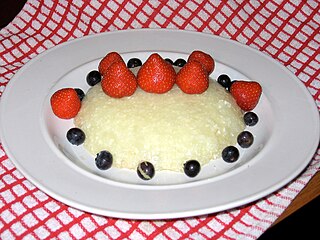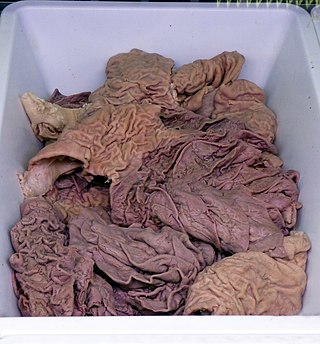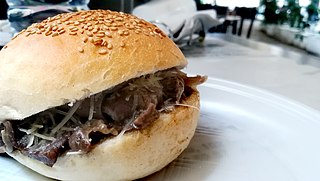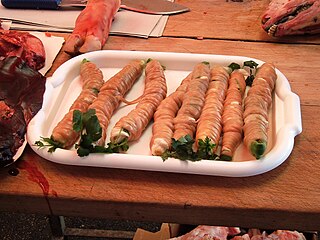
Molise is a region of Southern Italy. Until 1963, it formed part of the region of Abruzzi e Molise together with Abruzzo. The split, which did not become effective until 1970, makes Molise the newest region in Italy. Covering 4,438 square kilometres (1,714 sq mi), it is the second smallest region in the country, after the Aosta Valley, and has a population of 313,348.

Tripe is a type of edible lining from the stomachs of various farm animals. Most tripe is from cattle, pigs and sheep.

Offal, also called variety meats, pluck or organ meats, is the internal organs of a butchered animal. The word does not refer to a particular list of edible organs, and these lists of organs vary with culture and region, but usually exclude skeletal muscle. Offal may also refer to the by-products of milled grains, such as corn or wheat.

Peasant foods are dishes eaten by peasants, made from accessible and inexpensive ingredients.

Tripe soup or tripe stew is a soup or stew made with tripe. It is widely considered to be a hangover remedy.

Arancini, also known as, depending on the region but also on the different areas of the same region, arancine, are Italian rice balls that are stuffed, coated with breadcrumbs and deep-fried. They are a staple of Sicilian cuisine. The most common arancini fillings are: al ragù or al sugo, filled with ragù, mozzarella or caciocavallo cheese, and often peas, and al burro or ô burru, filled with ham and mozzarella or béchamel sauce.

Rigatoni con la pajata is a classic pasta dish of Roman cuisine. It can be found in some traditional trattorias in Rome.

Panelle are Sicilian fritters made from chickpea flour and other ingredients, usually including water, salt, pepper, olive oil, and finely chopped parsley. They are a popular street food in Palermo and are often eaten between slices of bread or on a sesame roll, like a sandwich. These sandwiches, called pane e panelle, are usually served with a slice of lemon to be squeezed over the panelle.

Pagliata is a traditional Roman dish primarily using the intestine of a young calf (tripe). As it has only eaten milk, the resulting dish is similar to cheese in a sausage casing.

Cheese pudding is a pudding made with cheese, which unlike cheesecake can be served at room temperature or frozen.

Lampredotto is a typical Florentine dish, made from the fourth and final stomach of cattle, the abomasum.

Frittola is a traditional Sicilian street food from the Palermo region of Italy. It is similar to the frittole from Reggio Calabria, but seems to use calf parts instead of pig.

Pani câ meusa, also spelled pani câ mèusa, is a Sicilian street food. Its Italianized name is panino con la milza. It is a dish typical of Palermo and it consists of a soft bread topped with sesame, stuffed with chopped veal lung and spleen that have been boiled and then fried in lard. Caciocavallo or ricotta may also be added, in which case the pani câ meusa is called maritatu ; if served without cheese, it is called schettu ('single') instead. It was created by Jewish butchers in Palermo, Sicily. It is sold mainly by street vendors in Palermo's main markets, such as the Vucciria and the Ballarò.

Pieds paquets or pied et paquets is a local dish and culinary specialty of Marseille and Sisteron but also commonly found in much of Southeastern France. It consists of sheep's feet and stuffed sheep's tripe stewed together.

Nasi padang, sometimes referred to as Padang rice, is a Minangkabau dish of steamed rice served with various choices of pre-cooked dishes originating from West Sumatra, Indonesia. It is named after the city of Padang, capital of the West Sumatra province. A miniature banquet of meats, fish, vegetables, and spicy sambals eaten with plain white rice, it is Sumatra's most famous export and the Minangkabau people's primary contribution to Indonesian cuisine.

The stigghiola, also known as stigghiuola, is a Sicilian food typical of the streets of the city of Palermo. It consists of guts which are washed in water and salt, seasoned with parsley and often with onion and other pot herbs, then stuck on a skewer or rolled around a leek, and finally cooked directly on the grill. The dish is generally prepared and sold as a street food. In Ragusa, the dish is baked in a casserole and is known as turciniuna.

Sekba or sometimes called bektim is a Chinese Indonesian pork offal stewed in a mild soy sauce-based soup. The stew tastes mildly sweet and salty, made from soy sauce, garlic, and Chinese herbs. It is a popular fare street food in Indonesian Chinatowns, such as Gloria alley, Glodok Chinatown in Jakarta, Indonesia.

Callos a la Madrileña is a stewed tripe dish, cooked slowly for hours over low heat, that is a speciality of Spanish cuisine associated with the city of Madrid. Traditionally pig or cow tripe was used but modern recipes use lamb or even cod. It includes pig snout and trotters, black pudding, sausage, ham, and soup vegetables like carrots and onions. When prepared correctly the broth is rich in gelatin and the tripe becomes very tender after the slow cooking process. The tripe can be browned before the cooking liquid is added, with trotter's, oxtails and other ingredients for the soup like ham, chorizo and smoked paprika. It is common to serve this stew with the morcilla blood sausage, a tapas dish typical of the region of Castile and León.
















